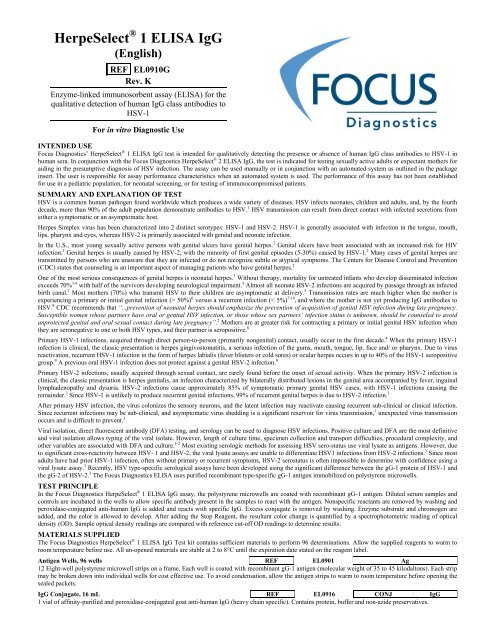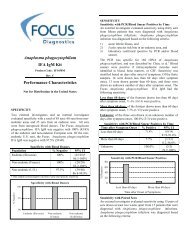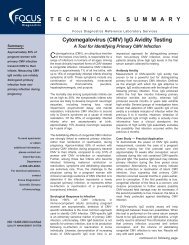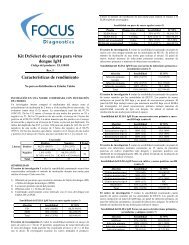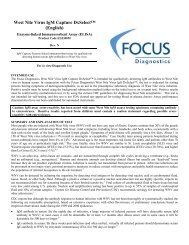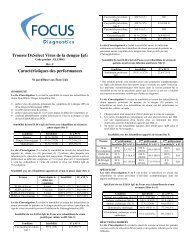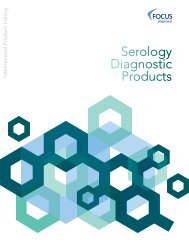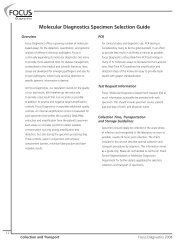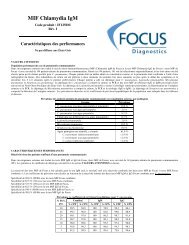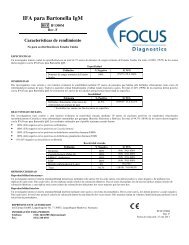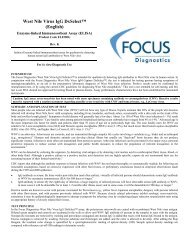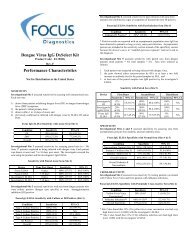HerpeSelect 1 ELISA IgG - Focus Diagnostics
HerpeSelect 1 ELISA IgG - Focus Diagnostics
HerpeSelect 1 ELISA IgG - Focus Diagnostics
- No tags were found...
Create successful ePaper yourself
Turn your PDF publications into a flip-book with our unique Google optimized e-Paper software.
<strong>HerpeSelect</strong> ® 1 <strong>ELISA</strong> <strong>IgG</strong>Page 41. All results from this and other serologies must be correlated with clinical history, epidemiological data, and other data available to the attending physicianin evaluating the patient.2. The prevalence of infection will affect the assay’s predictive value.3. As with other serological tests, negative results do not rule out the diagnosis of herpes simplex disease. The time required to seroconvert following primaryinfection varies with the individual, the specimen may have been drawn prior to the appearance of detectable antibodies. 15 There are reports of seroreversion.15,16 When appropriate, e.g., in suspected early herpes simplex disease, the test should be repeated or tested with a different assay. 2,14 If on retesting,the result remains negative, then a second sample should be drawn 4 to 12 weeks later and testing repeated. 14,154. False negative results may occur when the infecting virus is gG deficient, or because it is unknown if the assay’s antigen was glycosylated the same asmammalian cells. Liljeqvist reported about 0.2% (5/2400) HSV isolates were gG deficient. 175. As with other serological tests, false positive results may occur. Repeat testing or testing with a different device may be indicated in some settings, e.g.,patients with a low likelihood of HSV infection. 2,146. A single positive result only indicates previous immunologic exposure; level of antibody response or class of antibody response may not be used todetermine active infection or disease stage.7. The magnitude of the index value above the Cut-off does not indicate the total amount of antibody present.8. Serology cannot distinguish genital from oral infections. When appropriate, culture is recommended to identify the infection site. However, false negativeHSV cultures are common, especially in patients with recurrent infection or with healing lesions. 2LIMITATIONS1. The performance of this assay has not been established for the general population.2. The performance of this assay has not been established for ruling out diseases with similar symptoms, e.g., Candida albicans, Bacteriodes species, G.vaginalis, Mobiluncus species. Instead, also use culture or other appropriate methods.3. The performance of this assay has not been established for matrices other than serum, or visual result determination(s), or monitoring HSV-1 therapy.EXPECTED VALUESAn outside investigator assessed the device with masked, archived and unselected sera from 1) sexually active adults over the age of 14 (n = 246), and 2) fromexpectant mothers (n = 241). The reference method was a HSV-1 Western Blot from a Pacific Northwest university. The observed prevalences and thehypothetical predictive values for the 2 populations are shown in the tables below. The positive predictive value will decrease proportionally to the prevalence ofHSV infection as reflected in the table below. The calculations are based on <strong>Focus</strong> <strong>Diagnostics</strong> <strong>HerpeSelect</strong> ® 1 <strong>ELISA</strong> <strong>IgG</strong> having 1) a hypothetical sensitivity of91.2% and a hypothetical specificity of 92.3% (sexually active adults), and 2) a hypothetical sensitivity of 96.0% and a hypothetical specificity of 95.2%(expectant mothers).Observed Prevalence with Sexually Active Adults & Expectant MothersPopulationHSV-1 Sero-statusObserved PrevalenceWB<strong>Focus</strong> <strong>ELISA</strong>Sexually Active Adults*Neg 42.9% (105/245) 41.2% (101/245)Pos 55.9% (137/245) 56.7% (139/245)Expectant Mothers†Neg 25.7% (62/241) 22.4% (54/241)Pos 73.9% (178/241) 75.5% (1 82/241)* Excludes 3 atypical Western Blots and 2 <strong>ELISA</strong> equivocals.† Excludes 1 atypical Western Blot and 1 <strong>ELISA</strong> equivocal.Prevalence vs. Hypothetical Predictive ValuesPrevalenceSexually Active AdultsExpectant MothersPPV NPV PPV NPV50% 92.2% 92.3% 95.2% 95.2%40% 88.8% 94.7% 93.0% 96.7%30% 83.5% 96.5% 89.6% 97.9%25% 79.8% 97.3% 87.0% 98.3%20% 74.8% 98.0% 83.3% 98.8%15% 67.6% 98.5% 77.9% 99.1%10% 56.8% 99.1% 69.0% 99.4%5% 38.4% 99.6% 51.3% 99.7%Note: Sexually active adult and expectant mother populations in different geographic areas may produce different frequency distributions from the table above.Each laboratory should establish frequency distributions for their specific patient populations.PERFORMANCE CHARACTERISTICSSetting the Cut-OffIn designing the assay, the Cut-off was validated using 5 serum panels (n = 383) to initially assess performance: 1) clinical lab samples (n = 94); 2) clinical labsamples that were negative by screening <strong>ELISA</strong>s (n = 37); 3) clinical lab samples having unusual Western Blot or immunoblot reactivity (n = 32); 4) SpanishSTD clinic samples (n = 159); and 5) Pacific Northwest university samples (n = 61). The reference method was a HSV-1 Western Blot from a licensed clinicallaboratory. Excluding 2 atypical Western Blots, the <strong>Focus</strong> HSV-1 <strong>ELISA</strong> <strong>IgG</strong> and the Western Blot agreed 95.1% (116/122) with positives, and agreed 93.8%(243/259) with negatives. Of the 2 Western Blot atypical samples, 1 was <strong>ELISA</strong> negative and the other <strong>ELISA</strong> positive.Relative Sensitivity and Relative Specificity with Expectant Mothers†An outside investigator assessed the device’s relative sensitivity and relative specificity with sera from expectant mothers (n = 241). The sera were sequentiallysubmitted to the laboratory, archived, and masked. The reference method was a HSV-1 Western Blot (WB) from a Pacific Northwest university. Of 178 WBpositives, <strong>ELISA</strong> was 170 positives, 7 negatives and 1 equivocal. Of 62 WB negatives, <strong>ELISA</strong> was 59 negatives, and 3 positives. The 1 atypical WB was <strong>ELISA</strong>negative.
<strong>HerpeSelect</strong> ® 1 <strong>ELISA</strong> <strong>IgG</strong>Page 5Relative Sensitivity and Relative Specificity with Expectant Mothers (n = 241)†Characteristic % (EL/WB)* 95%CISensitivity relative to Western Blot 96.0% (170/177) 92.0-98.4%Specificity relative to Western Blot 95.2% (59/62) 86.5-99.0%* Excludes 1 atypical Western Blot and 1 <strong>ELISA</strong> equivocal.† The word “relative” refers to comparing this assay’s results with those of a similar assay. No attempt was made to correlate the assay results to diseasepresence or absence. No judgment can be made on the similar assay’s accuracy in predicting disease.Relative Sensitivity and Relative Specificity with Sexually Active Adults†An outside investigator assessed the device’s relative sensitivity and relative specificity with sera from sexually active adults over the age of 14 (n = 246). Thesera were sequentially submitted to the laboratory, archived, and masked. The reference method was a HSV-1 Western Blot from a Pacific Northwest university.Of 138 WB positives, <strong>ELISA</strong> was 125 positives, 12 negatives, and 1 equivocal. Of 105 WB negatives, <strong>ELISA</strong> was 96 negatives, 8 positives, and 1 equivocal. Of3 atypical WBs, <strong>ELISA</strong> was 1 negative and 2 positives.Relative Sensitivity and Relative Specificity with Sexually Active Adults (n = 246)†Characteristic % (EL/WB)* 95%CISensitivity relative to Western Blot 91.2% (125/137) 85.2-95.4%Specificity relative to Western Blot 92.3% (96/104) 85.4-96.6%* Excludes 3 atypical Western Blots and 2 <strong>ELISA</strong> equivocals.† The word “relative” refers to comparing this assay’s results with those of a similar assay. No attempt was made to correlate the assay results to diseasepresence or absence. No judgment can be made on the similar assay’s accuracy in predicting disease.Relative Sensitivity with Culture Positives†An outside investigator assessed the device’s relative sensitivity using sera from culture positive patients (n = 38). Reference methods included culture (infection)and a HSV-1 Western Blot (antibody) from a Pacific Northwest university. Of 38 culture positives: 1) WB was 37 positives and 1 negative; and 2) <strong>ELISA</strong> was 30positives and 8 negatives. Of the 37 WB positives, <strong>ELISA</strong> was 30 positives and 7 negatives.Relative Sensitivity with Culture Positives (n = 38) †Characteristic % (EL/WB or Culture) 95%CISensitivity relative to Culture 78.9% (30/38) 62.7-90.4%Sensitivity relative to Western Blot 81.1% (30/37) 64.8-92.0%† The word “relative” refers to comparing this assay’s results with those of a similar assay. No attempt was made to correlate the assay results to diseasepresence or absence. No judgment can be made on the similar assay’s accuracy in predicting disease.Agreement with CDC PanelThe following information is from a serum panel obtained from the CDC and tested by <strong>Focus</strong> <strong>Diagnostics</strong>. The results are presented as a means to convey furtherinformation on the performance of this assay with a masked, characterized serum panel. This does not imply an endorsement of the assay by the CDC. The panelconsists of 59% positive and 41% negative samples. The <strong>Focus</strong> <strong>Diagnostics</strong> <strong>HerpeSelect</strong> ® 1 <strong>ELISA</strong> <strong>IgG</strong> demonstrated 96.0% total agreement with the CDCresults. Of the results obtained by <strong>Focus</strong> <strong>Diagnostics</strong>, there was 93.1% agreement with the positive specimens and 100% agreement with the negative specimens.Relative Specificity with a Low Prevalence Population†An outside investigator assessed the device’s relative specificity using sera from a population of college students claiming to lack sexual experience (n = 81), andhaving a published HSV-1 antibody prevalence of 26.9% (50/186). 13 The laboratory reference method was a HSV-1 Western Blot from a Pacific Northwestuniversity. Of 57 WB negatives, <strong>ELISA</strong> was 55 negatives, 1 positive and 1 equivocal. Of 24 WB positives, <strong>ELISA</strong> was 18 positives and 6 negatives.Relative Specificity with a Low Prevalence Population (n = 81) †Characteristic % (EL/WB)* 95%CISpecificity relative to Western Blot 98.2% (55/56) 90.5-100%Sensitivity relative to Western Blot 75.0% (18/24) 53.3-90.2%* Excludes 1 <strong>ELISA</strong> equivocal.† The word “relative” refers to comparing this assay’s results with those of a similar assay. No attempt was made to correlate the assay results to diseasepresence or absence. No judgment can be made on the similar assay’s accuracy in predicting disease.Type Specificity with HSV-2 Western Blot PositivesAn outside investigator assessed the device’s type specificity using HSV-2 Western Blot positive and HSV- 1 Western Blot negative sera from the abovedescribed populations (n = 90): expectant mothers, sexually active adults, low prevalence persons, and HSV-2 culture positives. Of 90 HSV-2 WB positive andHSV-1 WB negative samples, <strong>ELISA</strong> was 82 negatives, and 8 positives.Type Specificity with HSV-2 Western Blot Positives (n = 90) †Characteristic % (EL/WB) 95%CIType specificity relative to Western Blot 91.1% (82/90) 83.2-96.1%Type cross-reactivity relative to Western Blot 8.9% (8/90) 3.9-16.8%† The word “relative” refers to comparing this assay’s results with those of a similar assay. No attempt was made to correlate the assay results to disease presenceor absence. No judgment can be made on the similar assay’s accuracy in predicting disease.Cross-reactivity with Taxonomically Related Viruses<strong>Focus</strong> assessed the device’s cross-reactivity using sera (n = 26) that were 1) HSV sero-negative by another manufacturer’s FDA cleared HSV <strong>ELISA</strong>s, and 2)IFA <strong>IgG</strong> positive for taxonomically similar viruses including CMV, EBV VCA, HHV6 and VZV. Discrepants between the FDA cleared HSV <strong>ELISA</strong>s and the<strong>Focus</strong> device were analyzed using a type specific Western Blot from a major university located in the Northwestern United States. Excluding 1 <strong>Focus</strong> <strong>ELISA</strong>equivocal that was not analyzed with the Western Blot because of insufficient volume, the results are:Cross-reactivity with Taxonomically Related VirusesIFA <strong>IgG</strong> Pos % <strong>Focus</strong> EL Neg (n/N) 95%CICMV 100% (12/12) 73.5-100%EBV VCA 100% (24/24) 85.5-100%HHV6 100% (24/24) 85.5-100%VZV 100% (23/23) 85.2-100%Total 100% (83/83) 95.7-100%
<strong>HerpeSelect</strong> ® 1 <strong>ELISA</strong> <strong>IgG</strong>Page 6Intra-assay and Inter-assay ReproducibilityAn internal investigator assessed the device’s intra-assay and inter-assay reproducibility by assaying 7 samples in duplicate, twice a day, for 20 days, for a totalof 40 runs. 2 sets of samples were masked duplicates.Inter-lot ReproducibilityAn internal investigator assessed the device’s inter-lot reproducibility. 7 samples were run on in duplicate and in parallel with 3 separate lots. Each of the 3 lotshad at least a different lot of Antigen Wells.Inter-laboratory ReproducibilityAn internal investigator and 2 off-site laboratories assessed the device’s inter-laboratory reproducibility. Each of the 3 laboratories ran 7 samples in triplicate on3 different days.ReproducibilityInter- & Intra-assay Inter-lot Inter-labSampleIntra-assay Inter-assayMean of LabIndex MeanIndex Mean Index %CV Index Mean%CV %CV%CVsLab%CV of Means11* 0.10 40.0% 50.4% 0.09 26.8% 0.15 6.6% 70.9%16* 0.10 0.0% 11.6% 0.09 20.2% 0.15 23.6% 63.1%12** 1.58 3.8% 7.0% 1.47 8.2% 1.44 13.5% 7.0%17** 1.55 40.0% 5.4% 1.41 2.9% 1.48 13.0% 4.3%13 2.67 3.6% 4.9% 2.48 11.1% 2.37 10.8% 5.7%14 3.08 3.9% 6.5% 2.64 9.4% 2.72 10.7% 7.5%15 11.96 2.2% 5.6% 10.85 25.1% 14.24 24.3% 64.6%* #11 & #16 are masked duplicates.** #12 & #17 are masked duplicates.% Agreement between the Manual & Automated MethodsAn internal and an external investigator compared % agreement between the <strong>HerpeSelect</strong> automated method vs. the manual method as part of a CLIA validationfor a major clinical laboratory located in Southern California. The external investigator sequentially selected and manually tested 248 samples. Each sample wasfrom an adult, and was submitted for HSV testing. 246 samples were from the U.S., and 2 samples from outside the U.S. Of the 248 samples, the manual methoddetected 108 negatives, 3 equivocals, and 137 positives. Of the 108 negatives by the manual method, the automated method agreed with 98.1% (106/108). Of the3 equivocals by the manual method, the automated method agreed with 66.7% (2/3). Of the 137 positives by the manual method, the automated method agreedwith 97.8% (134/137). Overall, the 2 methods agreed 97.6% (242/248). Of the 5 discrepants, 3 resolved in favor of the automated method, and the other 2 did notresolve.% Agreement between the Manual and Automated MethodsInterpretation* % Agreement 95%CINegative 98.1% (106/108) 93.5-99.8%Equivocal 66.7% (2/3) 9.4-99.2%Positive 97.8% (134/137) 93.7-99.5%Overall 97.6% (242/248) 94.8-99.1%* Interpretation by manual method.Reproducibility Using an Automated InstrumentAn internal investigator assessed the device’s inter-assay and intra-assay reproducibility with an automated instrument. 10 samples were tested in triplicate on 3different days. The manual and automated methods agreed 98.9% (87/90).Reproducibility Using an Automated InstrumentSample Mean Index Intra-assay %CV Inter-assay %CV2 0.2 7.8% 17.5%7 0.3 9.8% 3.1%8 0.4 6.7% 6.1%10 1.2 4.4% 6.2%9 2.0 7.6% 7.0%4 3.0 15.7% 3.9%5 3.9 6.8% 6.1%3 5.3 14.0% 2.2%1 5.6 13.5% 1.4%6 7.6 5.0% 8.0%Stability after Opening ReagentsAn internal investigator assessed stability after the reagents had been opened. The kit was used in the inter-assay/intra-assay reproducibility study (above), reclosed,stored at 2 to 8°C for at least 30 days, and then used again to re-test the same samples. There was 96.7% agreement with the index when the reagentswere opened.REFERENCES1. Aurelian, L. Herpes Simplex Viruses. 473-497. In Specter, S & G Lancz (eds.). Clinical Virology Manual. 2 nd Ed. Elsevier, New York. (1992).2. Centers for Disease Control and Prevention. Sexually transmitted diseases treatment guidelines 2002. MMWR 2002:5 1 (No. RR-6).3. Arvin, A, C Prober. Herpes Simplex Viruses. 876-883. In Murray, P, E Baron, M Pfaller, F Tenover, and R Yolkenet (eds.). Manual of ClinicalMicrobiology. 6th Ed. ASM, Washington, D.C. (1995).4. Whitley, R. Herpes Simplex Viruses. 2297-223 1. In Fields, B, D Knipe, P Howley, et al. (eds.). Fields Virology 3 rd Ed. Lippincott-Raven, Philadelphia.(1996).5. Whitley, R, A Nahmias, A Visintine, C Fleming, C Alford. Natural history of herpes simplex virus infection of mother and newborn. Pediatrics 66:489-494(1980).6. Whitley, R. Herpes simplex, in J Klein & J Remington (ed.), Infectious diseases of the fetus and newborn infants, 3 rd ed., p.282-305.7. Prober, C, W Sullender, L Yasukawa, D Au, A Yaeger, A Arvin. Low risk of herpes simplex virus infections in neonates exposed to the virus at the time ofvaginal delivery to mothers with recurrent herpes simplex virus infections. N Engl J Med 3 16:240-244 (1987).
<strong>HerpeSelect</strong> ® 1 <strong>ELISA</strong> <strong>IgG</strong>Page 78. Brown, Z, S Sleke, J Zeh, J Kopelman, A Maslow, R Ashley, D Watts, S Berry, M Herd, L Correy. The acquisition of herpes simplex virus duringpregnancy. N Engl J Med 337:509-515 (1997).9. 9. Prober CG, Corey L, Brown ZA et al. 1992. The management of pregnancies complicated by genital infections with herpes simplex virus. Clin InfectDis. 15:1031-1038.10. Brown ZA, Benedetti J, Ashley R et al. 1991. Neonatal herpes simplex virus infection in relation to asymptomatic maternal infection at the time of labor. NEngl J Med. 324:1247-1252.11. Stewart, J. Herpes Simplex Virus. 554-559. In Rose, N, E deMacario, J Fahey, H Friedman, G Penn (eds.). Manual of Clinical Laboratory Immunology. 4 thEd. ASM Press, Washington, D.C. (1992).12. NCCLS H18-A2. Procedures for the Handling and Processing of Blood Specimens; Approved Guideline. 2 nd Ed. (1999).13. Corey, L., A. Wald, New Developments in the Biology of Genital Herpes, in Clinical Management of Herpes Viruses, p.46.14. Ashley RL. Performance and use of HSV type-specific serology test kits. Herpes 2002 Jul;9(2):38-45.15. Ashley-Morrow R, Krantz E, Wald A. Time Course of Seroconversion by <strong>HerpeSelect</strong> <strong>ELISA</strong> After Acquisition of Genital Herpes Simplex Virus Type 1(HSV-1) or HSV-2. Sex Transm Dis. 2003 Apr;30(4):3 10-314.16. Cherpes TL, Ashley RL, Meyn LA, Hillier SL. Longitudinal reliability of focus glycoprotein G-based type-specific enzyme immunoassays for detection ofherpes simplex virus types 1 and 2 in women. J Clin Microbiol 2003 Feb;41(2):671-4.17. Liljeqvist et al.Typing of Clinical Herpes Simplex Virus Type 1 and Type 2 Isolates with Monoclonal Antibodies. J Clin Micro 37:2727-2718 (1999).18. CDC-NIH Manual. (1999) Biosafety in Microbiological and Biomedical Laboratories. 4 th ed. And National Committee for Clinical Laboratory Standards(NCCLS). Protection of Laboratory Workers from Instruments, Biohazards and Infectious Disease Transmitted by Blood, Body Fluids and Tissue (NCCLSM29-A).This package insert is available in French, German, Italian, and Spanish at www.focusdx.com, and may be available in other languages from your localdistributor.AUTHORIZED REPRESENTATIVEmdi Europa GmbH, Langenhagener Str. 71, 30855 Langenhagen-Hannover, GermanyORDERING INFORMATIONTelephone: (800) 838-4548 (U.S.A. only) (562) 240-6500 (International)Fax: (562) 240-6510TECHNICAL ASSISTANCETelephone: (800) 838-4548 (U.S.A. only) (562) 240-6500 (International)Fax: (562) 240-6526Visit our web site at: www.focusdx.comPI.EL0910GRev. KDate written: 31 March 2011Cypress, California 90630 USA


